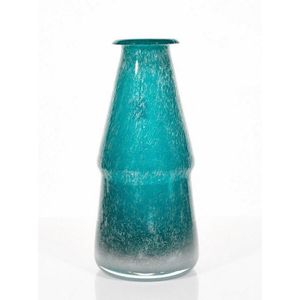Antique Crystal Vase with Butterfly Floral Decoration
You must be a subscriber, and be logged in to view price and dealer details.
Subscribe Now to view actual auction price for this item
When you subscribe, you have the option of setting the currency in which to display prices to $Au, $US, $NZ or Stg.
- Etched - Glass decorated with an etched design, which is achieved through marking out the pattern, protecting the area that is not be etched, and then immersing the object in acid to dissolve the surface of the unprotected area. With some glass objects, such as cameo glass, there may be several layers of different coloured glass, and part of the top layer is dissolved leaving the bottom layer as the background. The longer the time of exposure of the object to acid, the deeper the etching.
The word etching is also sometimes used to describe another method of decoration, where wheel grinders were used decorate the surface, but this technique is usually known as engraving. - Faceting - Faceting is a technique of removing material from a curved surface, to give a series of flat surfaces but retaining the profile of the original surface.
The technique is most commonly associated with diamond cutting where the various cuts used such as rose cut and brilliant cut, add life and sparkle to the stone, whilst at the same time removing as little of the stone as possible.
Faceting by grinding is also used to decorate glass. The stems of many drinking glasses are decorated by cutting a series of flat surfaces on a circular stem, and hollow vessels such as vases may have faceted surfaces.
In furniture faceting is often applied to legs of tables and chairs, where a circular baluster shaped section is flattened so as to form an octagonal section. - Circa - A Latin term meaning 'about', often used in the antique trade to give an approximate date for the piece, usually considered to be five years on either side of the circa year. Thus, circa 1900 means the piece was made about 1900, probably between 1895 and 1905. The expression is sometimes abbreviated to c.1900.
This item has been included into following indexes:
Visually similar items

Ruskin souffle hexagonal vase, in blue and beige, unusual tube lined mark to the base ?Ruskin England?. Height 11.5 cm

A good tall Daum Nancy glass vase, internal dark blue flecking graduating from the base to the lighter blue top, three panels of gold flecked highlights, the bulbous base tapering to a rolled form rim, wheel cut signature. Height 31.3 cm

Flavio Poli (Italian, 1900-1984). Pulegoso vase turquoise glass, labelled 'Seguso Vetri D'arte Murano made in Italy' and etched signature 'Seguso V. D'arte' to base, minor chip to neck

An unusual Bohemian cut glass and coloured glass obelisk, Circa 1900. 27 cm high
